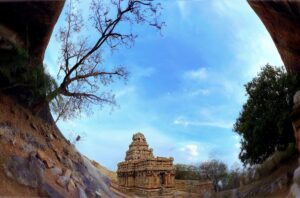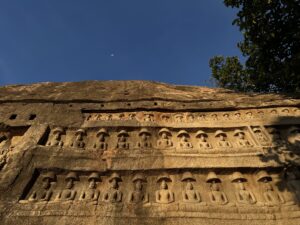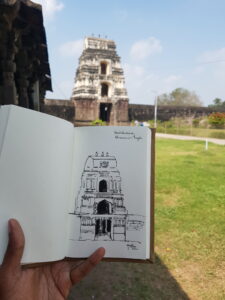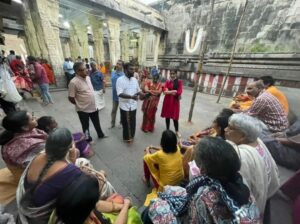Guided by personal beliefs, or simply the desire to visit sacred landmarks, more travelers are embarking on spiritual tourism.

As the fervour surrounding the consecration of the Ram Mandir in Ayodhya continues to captivate millions of visitors across all ages, the spiritual landscape of India seems to be experiencing a profound shift.
In acknowledgment of this transformative potential, Nirmala Sitharaman, the Union Finance Minister of India, announced a significant investment of ₹2,449.62 crore in the recent interim budget of 2024. This allocation is dedicated to enhancing the tourism infrastructure surrounding key religious sites nationwide, presenting unprecedented opportunities for local entrepreneurship.
Amidst these developments, the tourism industry is witnessing a tilt towards spiritual destinations especially among 20 and 30-year-olds. They are inspired to embark on spiritual journeys, guided by personal beliefs, quests for tranquility, or simply want to nurture the desire to tick sacred landmarks off their travel bucket lists.
Having grown up in a South Indian household, temple-hopping was a cherished family tradition for Niranjan Ganesh. Even during his formative years in Bahrain, any trip to India entailed mandatory visits to his grandparents’ home followed by an extensive temple tour.
Reflecting on those experiences, the Chennai resident reminisces, “Our routes would often include destinations like Tiruchendur, Nellaiappar, Thenkasi, Kutralam, or Kodaikanal, Madurai, Pillaiyarpetti. As a child, I was full of questions and curiosity, but as I grew older, temple visits became moments of pure serenity.”
Recalling a divine coincidence, the fitness coach and entrepreneur shares, “I’ve been to Sabarimala four or five times. The journey is arduous. On one occasion, I stepped on a small coconut shell on the 18 steps, injuring myself severely. I asked for a first aid center. Instead of redirecting me, the guardian at the gate graciously opened the main entrance, allowing me direct access. It was as if the divine didn’t intend cruelty but simply wished to spare me the long wait in queue.”
Echoing similar sentiments, Shweta Balambal recounts her life-changing experience during a visit to Omkareshwar temple – one of the 12 jyotirlingas in India. It had long been a dream for Shweta and her husband to make a pilgrimage to all 12 jyotirlingas before they turned 35 years old.
Typically, pilgrims undertake the sacred parikrama, a journey spanning approximately seven kilometres. “When we embarked on our journey, a few individuals guided us at the outset. As we progressed, we found ourselves too far along to turn back, with scarcely anyone in sight. We were concerned about our then three-year-old child. Suddenly, those same individuals we had encountered earlier appeared out of nowhere. Not only did they offer guidance, but they also graciously carried our son as the little one,” recalls the Bengaluru resident.
For some, it’s the profound sense of divine guidance that captivates them, while for others, it’s the opportunity to immerse themselves in the awe-inspiring architecture, intricate sculptures, and ancient inscriptions.
Take Madhav Subrahmanyam, for instance. Temples serve as a wellspring of inspiration for his artworks. A scroll through his Instagram page, aptly named Chitrasabha after a temple in Courtallam, unveils his artistic journey.

Chozhar Temple, Pudhukottai | Niveda. (Supplied)
Hailing from Rajahmundry and currently residing in Chennai, Subrahmanyam embraces every opportunity to sketch within temple premises. “I vividly recall my visit to Kurungaleeswarar temple during the Ram Mandir consecration,” he reminisces.
Located in Koyambedu, the temple holds significance as the reputed site visited by Lava and Kusa, sons of Rama. Being immersed in such sacred vibrations was truly transformative. For Subrahmanyam, temples serve as more than just architectural marvels; they are repositories of moral teachings and cultural heritage.
“Each temple harbours its unique stories and historical importance. Through my art, I aim to capture and preserve these narratives, channeling my devotion into creative expression,” he explains.
Driven by their shared passion for art, Tamil Nadu-based husband-wife duo Niveda and Meganath found themselves drawn to temples and their artistic treasures.

For Niveda and Meganath, each temple visit promised unexpected discoveries and delights. (Supplied)
Reflecting on his childhood skepticism, Meganath recalls, “In my 10th grade, I began questioning the existence of gods when my prayers went unanswered. I couldn’t help but wonder why none of the gods chose dinosaurs as their mounts, considering their ancient lineage.”
For the couple, each temple visit promises unexpected discoveries and delights. “While everyone talks about the awe-inspiring caves of Ellora and Ajanta, there’s a lesser-known gem in Kazhugumalai — a monolithic wonder that deserves recognition,” Niveda shares. “We gravitate towards temples that retain their authenticity and charm, avoiding overly commercialised sites,” she adds.
Their temple explorations are marked by hours spent marveling at the intricate designs adorning walls and floors. Among their favourite sculptures is in Badami, Karnataka — a depiction of a woman gracefully covering her breast.
Recalling another cherished experience, Niveda reminisces, “During our visit to Brahmadesam, where the memorial tomb of Rajendra Chola resides, we encountered several inscriptions by various rulers, each revealing subtle differences in language and script. This sparked our interest in ancient Tamil texts and led us on a quest for more inscriptions.”
In recent years, Madhusudhanan Kalaichelvan, a passionate heritage conservationist and architect, has observed a surge in youthful enthusiasm for temple exploration, particularly following the cinematic adaptation of Ponniyin Selvan.
“Today’s youth approach temples with a multifaceted perspective, moving beyond mere religious reverence,” Madhusudhanan notes. “A decade ago, my epigraphy classes primarily attracted individuals aged 55 and above. Now, the average participant age has dropped to 42 — a notable shift reflecting diverse interests and backgrounds.”
As the founder of Ride Into A World Of Myth And Music (RATHAM), a nonprofit organisation offering guided heritage tours, Madhusudhanan is committed to nurturing this burgeoning interest.
“Students join our heritage tours driven by genuine curiosity, and I strive to accommodate their varied interests,” he explains. “By emphasising the social, historical, archaeological, and cultural significance of temples, we aim to ignite a passion beyond religious contexts.”
The impact of RATHAM’s immersive experiences extends far beyond geographical boundaries, with a couple from Qatar making monthly pilgrimages to participate in the tours, celebrating birthdays and anniversaries amidst their explorations.
Describing the holistic approach of RATHAM, Madhusudhanan highlights how participants not only savour the unique prasadam offered by the temple but also immerse themselves in soul-stirring renditions of thevaram and divya parabandham by accompanying musicians and sometimes odhuvars (who sing devotional hymns but are not necessarily priests).
Nadaswaram players add to the ambiance, while priests provide insights into the intricate rituals and adornments of the deities. Every aspect of the experience is meticulously crafted to inspire awe and appreciation.
As the younger generation shows a growing interest in heritage, thanks to social media, renowned historian Chithra Madhavan voices concern about the spread of misinformation. “Every aspect of temples, from architecture to inscriptions, is imbued with spirituality. They are not just physical structures but spiritual entities that also encapsulate social, economic, and political dimensions,” she emphasises.

There is a concerning amount of factual inaccuracies on social platforms. (Supplied)
The temple historian urges content creators to exercise caution and accuracy when disseminating information, urging consumers to be discerning in their sources. “There is a concerning amount of factual inaccuracies on platforms like YouTube, which can mislead the public,” she notes.
“There are students of history and archaeology who undergo a certain rigour to specialise in this subject. People need to rely on credible sources and expert blogs for a deeper understanding of history,” she insists.
Sharing similar concerns, Niveda expresses dismay at the exploitation of temples for content creation and the resulting deterioration of their sanctity. “Unfortunately, some individuals deface these peaceful structures for their gain,” she laments. “We recently visited a temple in Seeyamangalam, hoping for a serene experience, only to find it overcrowded and marred by vandalism.”
Taking a proactive approach, Shweta emphasises the importance of teaching her son responsible travel practices from a young age. “We make a conscious effort to minimise our environmental impact,” she explains. “We bring our reusable lunch boxes and bottles to reduce littering.”
Shweta’s travel philosophy revolves around quality over quantity, opting for meaningful experiences over a rushed itinerary. “Unlike our parents’ generation, we prefer to savour each moment rather than rushing from one temple to another,” she shares. “Our favorite ritual is the night arthi at the Kashi Vishwanath temple in Benares, where local boys sing Lord Shiva to sleep.”
Temple tourism presents a paradoxical challenge. As promotion increases, so does the influx of visitors, leading to concerns about commercialisation.
“We inadvertently fuel commercialism,” laments Subrahmanyam. “In a country with the second-largest population, everyone seeks exclusive ticketed darshans, leaving little room for compromise. How can we expect the situation to improve?”
Reflecting on the complexities, Niranjan suggests, “A temple’s fame often hinges on the promotion surrounding it, attracting visitors for various reasons. However, individuals in positions of power have the potential to enact positive change. For example, the government’s initiative to promote Shiva Ratri two years ago was commendable. The narrative matters.”
Niranjan advocates for highlighting the temple’s history and photogenic spots to capture the attention of the younger generation. “Awareness efforts need to cater to Gen Z preferences. We must have forums where the youth can engage in constructive conversations with experts. Quirky fashion souvenirs like kurtas featuring temple designs could also pique their interest.”
Looking ahead, Meganath envisions leveraging Artificial Intelligence to present literature in an engaging format for youngsters. “Books are a treasure house of information about our temples. Through technology, we can make this knowledge more accessible to youngsters.”
Chithra Madhavan stresses the importance of grassroots education, nurturing an awareness and appreciation for culture from an early age.
“From school-going children to PhD scholars, participants in my history walks ask some of the most insightful questions. I ensure the information remains accessible to all, avoiding excessive technical jargon,” she shares.
Madhusudhanan underscores the need to shine a spotlight on lesser-known temples.
“In Tirunelveli, the Nellaiappar temple is undeniably iconic. However, we prioritise exploring lesser-known gems in Kallidaikurichi, Ambasamudram, and Thiruvidaimarudur. Places like Thiruvaiyar in Tanjore and the Royal Palace Museum and the Art Gallery remain underexplored, overshadowed by the grandeur of Brihadeeshwar temple,” he elaborates.

People should explore lesser-known gems. (Supplied)
Highlighting the multifaceted nature of temples beyond religious significance, Madhusudhanan stresses the importance of promoting them as social spaces, especially in the evenings.
“Both governmental and non-governmental agencies should focus on better promotion and maintenance of these hidden treasures. Excessive cosmetic changes can detract from the temple’s original charm. Sensitivity and careful preservation are essential,” he cautions.
Looking ahead, Madhusudhanan suggests integrating heritage education into school curriculum and advocating for the creation of heritage clubs and quarterly programs for middle school children.
“I was asked to accompany school students during a trip to Hampi but I couldn’t. So I prepared a presentation detailing key points for each site they would visit. Encouraging them to document their observations and photos in a scrapbook instills a sense of pride in their heritage,” he explains.
Niranjan emphasises the importance of educating future generations while also acknowledging realistic expectations. “Even Swami Vivekananda posed numerous questions to Ramakrishna Paramahansa, seeking enlightenment. Let’s responsibly leave behind our legacy, nurturing curiosity and respect for our heritage,” he concludes.

Jun 05, 2024

Jun 05, 2024

Jun 03, 2024

Jun 03, 2024

May 02, 2024

May 02, 2024